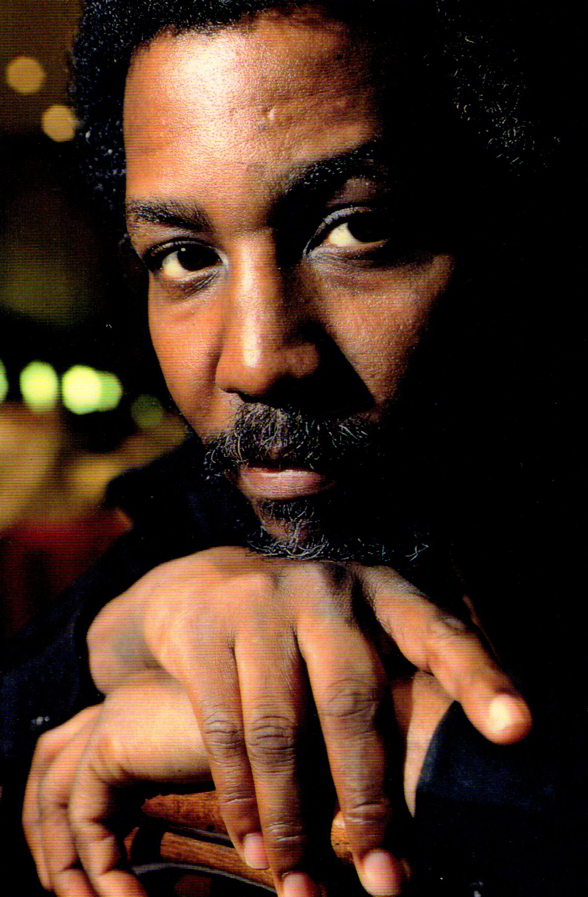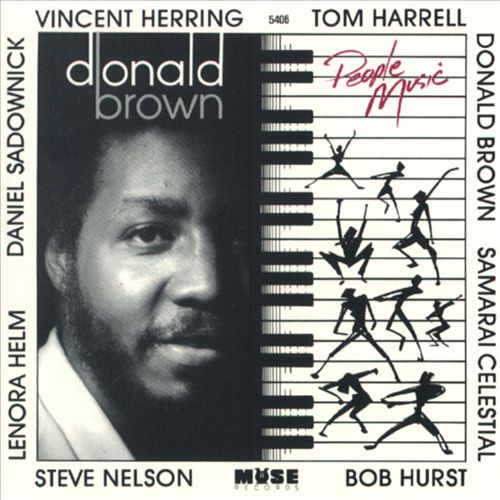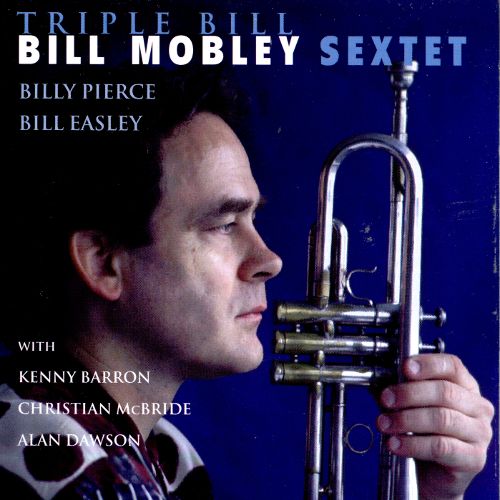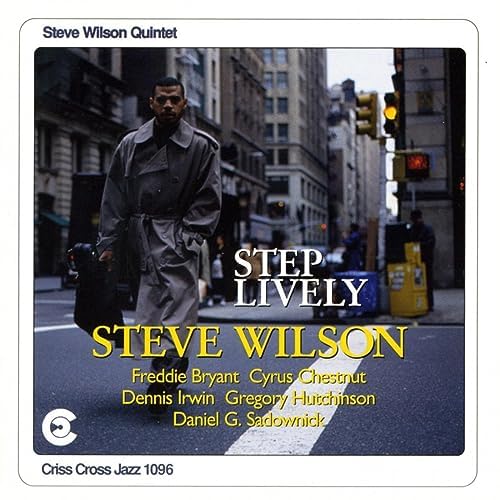I Love It When You Dance That Way – Donald Brown
This bright, catchy samba has been recorded quite a few times at a variety of tempos, both instrumentally and vocally. Listen to each version for different ways of interpreting the form and the wide melodic range.
- Recording: Donald Brown - People Music
- Recorded on: March 19 & 21, 1990
- Label: Muse (MCD 5406)
- Concert Key: No key center
- Vocal Range: , to
- Style: Latin (Samba)
- Vocals - Lenora Helm
- Flugelhorn - Tom Harrell
- Flute - Vincent Herring
- Vibes - Steve Nelson
- Piano - Donald Brown
- Bass - Robert Hurst
- Drums, Vocals - Eric Walker
- Percussion - Daniel Sadownick
Video
- Description
- Historical Notes
- Solos
- Piano Corner
- Bass Corner
- Drum Corner
- Guitar Corner
- Inside & Beyond
- Minus You
This first recording, at a medium samba tempo, has an eight-measure intro which starts with four measures of conga alone, then adds the drum set. Our audio excerpt starts with the tom-tom setup to the instrumental melody and fades out on the last two measures of the melody chorus.
Catchy and flowing with a bright vibe, this song has the feel of a standard—though not without a bit of a challenge. The uneven form is 37 measures long, divided into an 18-measure section and a similar 19-measure section. These are labeled on our lead sheets as A1 and A2, as the first 13 measures are identical. The changes have a lot of standard II-V7 movement, but there is no key center. Though the end of the form suggests a resolution into C major, there are no C major chords; the beginning uses C7 as a "V of V" resolution to B♭ major.
This song has a cyclical form, resolving back at the end to the beginning of the next chorus. The recordings of this song show different ways to deal with the ending. On this first version, the out melody repeats and fades out; this is shown on our lead sheets as "ending: vamp and fade melody", with the first note of the melody shown to continue the phrase.
This recording features both instrumental and vocal melody choruses; check out the vocal version for more details about the latter. The melody is played first instrumentally, then sung by the two vocalists in octaves; the horns and vibes double the vocals. The last two measures are played instrumentally in this chorus. This is followed by a piano solo chorus with wordless vocal melody as a background almost throughout (except the last two measures). After the vocal out head (same format as the vocal in head), there is another chorus of wordless vocal melody, doubled by the flute with flugelhorn and vibes improvising together over it. This chorus is repeated and fades out.
Though all recordings have a samba groove, the tempo marking on our lead sheets is "samba or bossa" as it would also work at a slower bossa tempo.
Note: all instrumental lead sheets for this composition are identical, no matter which album cover they are displayed under.
Catchy and flowing with a bright vibe, this song has the feel of a standard—though not without a bit of a challenge. The uneven form is 37 measures long, divided into an 18-measure section and a similar 19-measure section. These are labeled on our lead sheets as A1 and A2, as the first 13 measures are identical. The changes have a lot of standard II-V7 movement, but there is no key center. Though the end of the form suggests a resolution into C major, there are no C major chords; the beginning uses C7 as a "V of V" resolution to B♭ major.
This song has a cyclical form, resolving back at the end to the beginning of the next chorus. The recordings of this song show different ways to deal with the ending. On this first version, the out melody repeats and fades out; this is shown on our lead sheets as "ending: vamp and fade melody", with the first note of the melody shown to continue the phrase.
This recording features both instrumental and vocal melody choruses; check out the vocal version for more details about the latter. The melody is played first instrumentally, then sung by the two vocalists in octaves; the horns and vibes double the vocals. The last two measures are played instrumentally in this chorus. This is followed by a piano solo chorus with wordless vocal melody as a background almost throughout (except the last two measures). After the vocal out head (same format as the vocal in head), there is another chorus of wordless vocal melody, doubled by the flute with flugelhorn and vibes improvising together over it. This chorus is repeated and fades out.
Though all recordings have a samba groove, the tempo marking on our lead sheets is "samba or bossa" as it would also work at a slower bossa tempo.
Note: all instrumental lead sheets for this composition are identical, no matter which album cover they are displayed under.
Donald Brown's fourth album as a leader, "People Music" was the first of his to feature vocals, though only on this song. Lenora Helm also sang on Donald's next album, "Cause And Effect," a year later; she has also recorded with Antonio Hart and pianist Dona Carter. The other vocalist on this song is the drummer, Eric Walker; this seems to be his only vocal recording. Walker is best known for his work in Sun Ra's Arkestra; in this band he used the name Samarai Celestial, which is how he is credited on the cover of "People Music."
Related Songs
Email Send I Love It When You Dance That Way to a friend
Send this page to a friend via email. Add your name or email in the first field. In the second, add one or more email addresses, separated by a comma.
- Recording: Bill Mobley - Triple Bill
- Recorded on: June 28, 1993
- Label: Evidence (22163)
- Concert Key: No key center
- Vocal Range: , to
- Style: Latin (Samba)
- Trumpet - Bill Mobley
- Flute - Bill Easley
- Soprano Sax - Bill Pierce
- Piano - Kenny Barron
- Bass - Christian McBride
- Drums - Alan Dawson
- Percussion - Ron McBee
Video
- Description
- Historical Notes
- Solos
- Piano Corner
- Bass Corner
- Drum Corner
- Guitar Corner
- Inside & Beyond
- Minus You
Our audio excerpt starts right at the beginning, with a quarter note drum pickup to the melody.
On this faster recording, the melody is played once at the beginning, with no intro. The last melody phrase extends to a C on the downbeat of the first solo chorus. There are no backgrounds on the solos, but after the out head there are two more choruses with the horns playing the head again, and the piano soloing. These choruses have a long fade out, as in the original version.
The lowest note of the melody, G on the fourth beat of the fourth measure, is off the range of the soprano saxophone. Both Billy Pierce on this recording and Steve Wilson on his "Step Lively" recording play this note an octave higher, while the other melody instruments play it in the lower octave (relative to their range—on flute the entire melody is an octave up).
On this faster recording, the melody is played once at the beginning, with no intro. The last melody phrase extends to a C on the downbeat of the first solo chorus. There are no backgrounds on the solos, but after the out head there are two more choruses with the horns playing the head again, and the piano soloing. These choruses have a long fade out, as in the original version.
The lowest note of the melody, G on the fourth beat of the fourth measure, is off the range of the soprano saxophone. Both Billy Pierce on this recording and Steve Wilson on his "Step Lively" recording play this note an octave higher, while the other melody instruments play it in the lower octave (relative to their range—on flute the entire melody is an octave up).
Trumpeter/composer/bandleader Bill Mobley first recorded on Donald Brown's debut album as a leader, "Early Bird," in 1987. His next recording was another pianist's first album, Geoffrey Keezer's "Waiting In The Wings," also featuring saxophonist Bill Pierce. By the time of "Triple Bill," Mobley's first recording as a leader, he had played on Bill Easley and Alan Dawson albums. This recording is the only one to feature both Christian McBride and Alan Dawson.
For more songs from this album check out Bill Mobley's Three Gifts and James Williams' Mulgrew's Motif.
For more songs from this album check out Bill Mobley's Three Gifts and James Williams' Mulgrew's Motif.
Related Songs
Email Send I Love It When You Dance That Way to a friend
Send this page to a friend via email. Add your name or email in the first field. In the second, add one or more email addresses, separated by a comma.
- Recording: Steve Wilson - Step Lively
- Recorded on: April 27, 2019
- Label: Criss Cross (1096)
- Concert Key: No key center
- Vocal Range: , to
- Style: Latin (Samba)
- Soprano Sax - Steve Wilson
- Guitar - Freddie Bryant
- Piano - Cyrus Chestnut
- Bass - Dennis Irwin
- Drums - Gregory Hutchinson
- Percussion - Daniel Sadownick
Video
- Description
- Historical Notes
- Solos
- Piano Corner
- Bass Corner
- Drum Corner
- Guitar Corner
- Inside & Beyond
- Minus You
This even faster version opens with a conga intro (included in our audio excerpt) by Daniel Sadownick, who had also played on the original recording. The in head is played twice, followed by the first half of the melody yet again as a background for the piano solo. The out head is played once, and the last phrase ritards into a final C7 chord; this is the only recording of the song that does not have a vamp or fade out ending.
By the time of this recording, Steve Wilson had played on two Donald Brown albums: "Send One Your Love" in June 1992, and "Cartunes" in September '93, the latter with Bill Mobley. Also in December 1993, Steve recorded with Rob Bargad and a live album with Louie Bellson's big band.
Related Songs
Email Send I Love It When You Dance That Way to a friend
Send this page to a friend via email. Add your name or email in the first field. In the second, add one or more email addresses, separated by a comma.
- Recording: Darryl Hall - Swingin' Back
- Recorded on: April 27, 2018
- Label: Space Time (BG 1947)
- Concert Key: No key center
- Vocal Range: , to
- Style: Latin (Samba)
- Piano - Keith Brown
- Bass - Darryl Hall
- Drums - Kenneth Brown
Video
- Description
- Historical Notes
- Solos
- Piano Corner
- Bass Corner
- Drum Corner
- Guitar Corner
- Inside & Beyond
- Minus You
This recording begins with a one-measure pickup to an eight-measure drum intro; this is included in our audio excerpt.
Daryl Hall's version is around the same tempo as the original Donald Brown recording. The head is once in and once out. The bass plays the melody unison with the piano at A1; on A2 the bass goes to a 2-feel while the piano continues the melody. Solos start right on it with no continuation of the melody into the solo chorus.
There is yet another ending: the last two measures are tagged two more times, followed by a vamp on Cmaj7(♯11) to a final chord.
Daryl Hall's version is around the same tempo as the original Donald Brown recording. The head is once in and once out. The bass plays the melody unison with the piano at A1; on A2 the bass goes to a 2-feel while the piano continues the melody. Solos start right on it with no continuation of the melody into the solo chorus.
There is yet another ending: the last two measures are tagged two more times, followed by a vamp on Cmaj7(♯11) to a final chord.
Recorded in Paris, "Swingin' Back" features Donald Brown's sons, Keith Brown on piano and Kenneth Brown on drums. Kenneth also played on Donald's 2012 album "Born To Be Blue."
Related Songs
Email Send I Love It When You Dance That Way to a friend
Send this page to a friend via email. Add your name or email in the first field. In the second, add one or more email addresses, separated by a comma.

Donald Brown
born on March 28, 1954
A lyrical pianist and prolific composer as well as a teacher, band leader and arranger, Donald Brown is considered one of the masters of contemporary jazz composition. Raised in Memphis, Tennessee, Donald studied trumpet and drums as a youth. It was not until he began studying at Memphis State University that he switched to piano as his primary instrument, the late start making his pianistic skill all the more incredible. Read more...
There was a problem.
...




